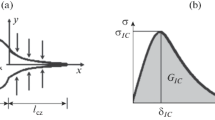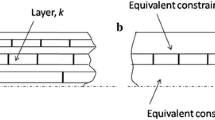A systematic evaluation of the interlayer crack resistance in the modes I and II loadings of a glass fiber epoxy laminated composite by experimental and computational methods using the cohesive zone model was carried out. The local properties (the ultimate stress σC, the maximum displacement δmax, and the specific work of fracture γF) of the cohesive zone were determined experimentally by the methods of separation and shear of the layer contact zone; the critical intensities of elastic energy release (GIC and GIIC) were found by the method of linear elastic fracture mechanics. Based on the experimental data obtained, the critical length of the cohesive zone was calculated by the Barenblatt micromechanical theory. A numerical evaluation of the crack resistance of a laminated composite under conditions of static loading in the modes I and II was carried out using 3D finite-element models of a double-cantilever beam and end-notched flexure specimens with an implemented cohesive zone obeying the exponential law. The optimal number of interface elements in the finite-element mesh was determined for the cohesive zone calculated based on experimental data, which ensured a sufficient accuracy of numerical calculating the ultimate load of the onset of crack growth and the stress distribution along the length of the cohesive zone with a minimum number of calculations. The approach proposed and the results obtained showed a good agreement between the calculated and experimentally determined characteristics of standard specimens of glass fiber epoxy composite and can be used to calculate the interlayer strength and crack resistance of structural members with a complex geometry made of layered polymer composites.






Similar content being viewed by others
References
A. I. Preobrazhensky, “Glass-fiber-reinforced plastics: properties, technologies, and application,” Glavnyi Mekhanik, No. 5, 27-36 (2010).
T. P. Sathishkumar, S. Satheeshkumar, and J. Naveen, “Fiberglass-reinforced polymer composites — a review,” J. Reinf. Plastics and Compos., 33, No. 13, 1258-1275 (2014).
A. N. Vorontsov, G. Kh. Murzakhanov, and V. N. Shchugorov, “Delamination failure of composite structure,” Mech. Compos. Mater., 6, 1007-1023 (1989).
H. B. Kahla, Z. Ayadi, and J. Varna, “Local delaminations induced by interaction between intralaminar cracking and specimen edge in quasi-isotropic CF/EP NCF composites in fatigue loadings,” Mech. Compos. Mater., 56, No. 3, 291-302 (2020).
V. E. Strizhius, “A methodology for estimating the delamination growth rate in layered composites under tensile cyclic loading,” Mech. Compos. Mater., 56, No. 4, 533-540 (2020).
L. Wang, C. Zheng, H. Luo, S. Wei, and Z. Wei, “Continuum damage modeling and progressive failure analysis of carbon fiber/epoxy composite pressure vessel,” Heavy Castings and Forgings, 475-480 (2015).
T. K. O’Brien, “Development of a composite delamination fatigue life prediction methodology,” NASA Technical Reports Server, 1-9 (2009).
J. Bertolini, B. Castanié, J. J. Barrau, and J. P. Navarro, “Multi-level experimental and numerical analysis of composite stiffener debonding,” Part 1, Nonspecific Specimen Level, Composite Structures, 90, 381-391 (2009); Part 2, Element and Panel Level, Compos. Struct., 90, 392-403 (2009).
P. Babaevsky and S. Kulik, Crack Resistance of Cured Polymer Compositions [in Russian], Khimiya, Moscow (1991).
A. J. Brunner, B. R. K. Blackman, and P. Davies, “A status report on delamination resistance testing of polymer matrix composites,” Eng. Fracture Mech., 75, 2779-2794 (2008).
V. M. Mirsalimov, “Modeling the initiation and propagation of cracks in a fibrous composite under loading across fibers,” Mech. Compos. Mater., 56, No. 6, 721-734 (2021).
V. D. Krylov, N. O. Yakovlev, Yu. A. Kurganova, and O. A. Lashov, “Interlayer crack resistance of structural polymer composite materials,” Aviats. Mater.Tekhnologii, 40, No. 1, 79-85 (2016).
N. Trivedi, S. Das, and E.-M. Craciun, “The mathematical study of an edge crack in two different specified models under time-harmonic wave disturbance,” Mech. Compos. Mater., 58, No. 1, 1-14 (2022).
R. Krueger, “Virtual crack closure technique: History, approach, and applications,” Appl. Mech. Rev., 57, No. 2, (2004).
E. Pietropaoli, “Virtual crack closure technique and finite-element method for predicting the delamination grows initiation in composite structures,” Intechopen.com (2008).
A. Hillerborg, M. Modéer, and P. Petersson, “Analysis of crack formation and crack growth in concrete by means of fracture mechanics and finite elements,” Cement Concrete Res., 6, No. 6, 773 (1976).
G. Alfano and M. Crisfield, “Finite-element interface models for the delamination analysis of laminated composites: mechanical and computational issues,” Int. J. Numerical Methods in Eng., 50, No. 7, 1701-1736 (2001).
A. Turon, C. G. Dávila, P. P. Camanho, and J. Costa, “An Engineering solution for using coarse meshes in the simulation of delamination with cohesive zone models,” NASA/TM, 213547 (2005).
P. Harper and S. Hallett, “Cohesive zone length in numerical simulations of composite delamination,” Eng. Fract. Mech., 75, No. 16, 4774-4792 (2008).
P. Harper and S. R. Hallett, “A fatigue degradation law for cohesive interface elements — Development and application for composite materials,” Int. J. Fatigue, 32, 1774-1787 (2010).
B. Cox and Q. Yang, “Cohesive models for damage evolution in laminated composites,” Int. J. Fract., 107-137 (2005).
Moslemi M., Khoshravan M. Cohesive zone parameters selection for mode I prediction of interfacial delamination,” J. Mech. Eng., 61, No. 9, 507 (2015).
P. G. Babayevsky, N. V. Salienko, and G. V. Novikov, “Use of experimentally determined parameters of the cohesive zone in the numerical evaluation of the resistance to delamination of polymer composites materials,” Inorg. Mater. Appl. Res., 10, No. 5, 1259 (2019).
G. I. Barenblatt, “The mathematical theory of equilibrium cracks in brittle fracture,” Adv. Appl. Mech.,7, 55 (1962)
Z. Z. Wang, J. Zhao, X. Ma, S. J. Wang, and X. Yang, “Numerical simulation of progressive delamination in composite laminates under mode I and mode II loadings,” Mech. Compos. Mater., 56, No. 6, 735-746 (2021).
S. Masooda, A. Singh, and S. Viswamurthy, “Simulation & validation of delamination growth in CFRP specimens under mixed mode loading using cohesive elements,” Proceedings of 14th ISAMPE National Conference on Composites (INCCOM-14), Hyderabad (2016).
GOST 19170-2001. Fiberglass. Construction fabric. Specifications, Standards Publishing House, Minsk.
Yu. M. Tarnopolsky and T. Ya. Kintsis, Methods of Static Testing of Reinforced Plastics [in Russian], Khimiya, Moscow (1981).
Standard 56815-2015. Polymer composites. Method for determination of the specific work of exfoliation in tearing off conditions GIC, Standardinform, Moscow.
Standard 33685-2015. polymer composites. Test method for determination of the interlaminar fracture toughness under shear GIIC, Standardinform, Moscow.
M. Moslemi and M. K. Azar, “Delamination analysis of woven fabrication laminates using cohesive zone model,” J. Cent. South Univ., 23, 27-38 (2016).
GOST 56805-2015. Polymer composites. Methods for determining mechanical characteristics in bending, Standartinform, Moscow.
Author information
Authors and Affiliations
Corresponding author
Rights and permissions
Springer Nature or its licensor (e.g. a society or other partner) holds exclusive rights to this article under a publishing agreement with the author(s) or other rightsholder(s); author self-archiving of the accepted manuscript version of this article is solely governed by the terms of such publishing agreement and applicable law.
About this article
Cite this article
Babaevsky, P.G., Salienko, N.V. & Shatalin, A.A. Evaluating the Local Strengh and Crack Resistance of an Glass Fiber Epoxy Composite in the Interlayer Tension and Shear Using a Finite-Element Model and Experimentally Determined Parameters of the Cohesive Zone. Mech Compos Mater 59, 713–724 (2023). https://doi.org/10.1007/s11029-023-10126-6
Received:
Revised:
Published:
Issue Date:
DOI: https://doi.org/10.1007/s11029-023-10126-6




